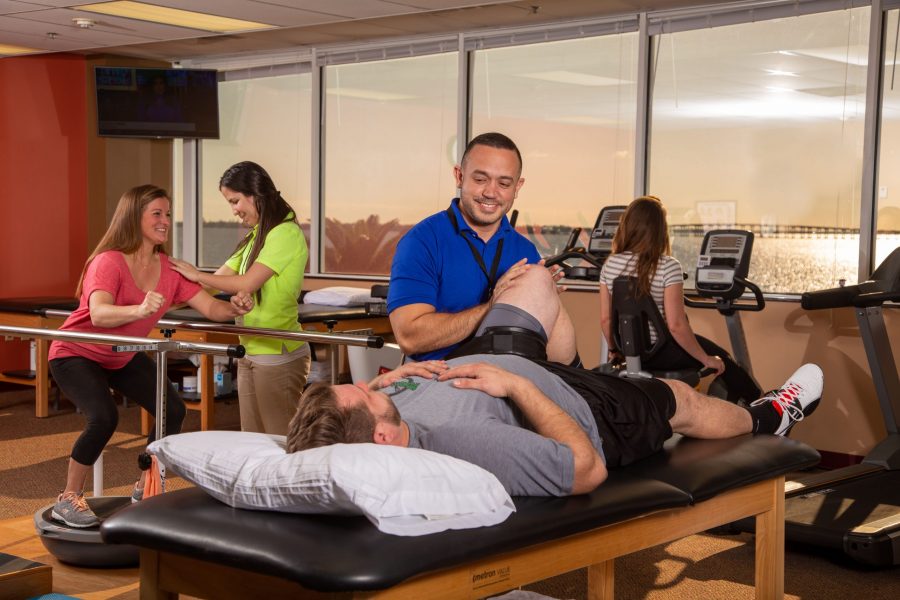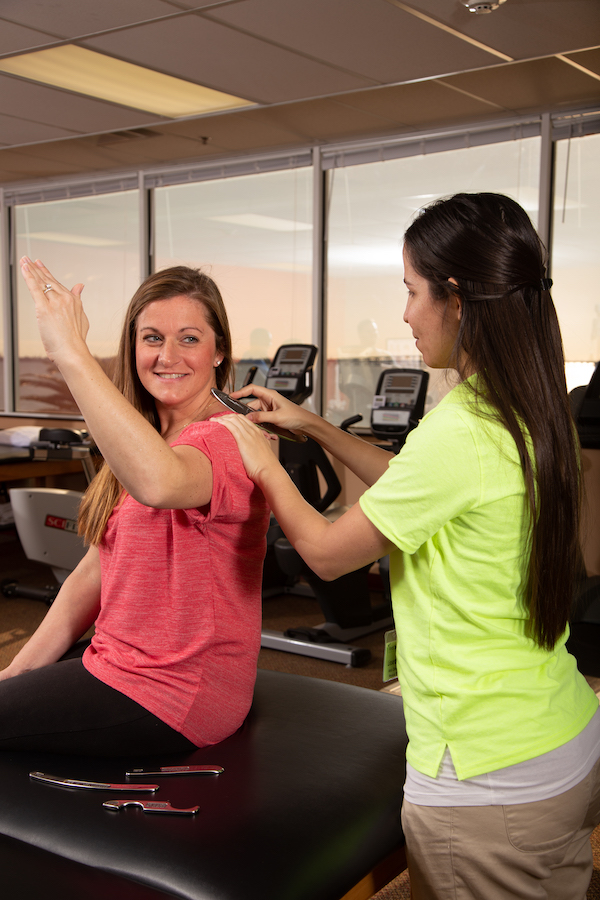First Choice Orthopaedics provides patients with a non-surgical treatment option.
Injuries are bound to happen. Whether you lead an active lifestyle or a more sedentary lifestyle, you still move, and are therefore subject to risk. Though you may not think working in an office can put your body at risk, you can still twist your ankle walking to and from your car or pull a muscle as you sit hunched over at your desk. And those who are more athletic can hurt themselves on a run, at the gym or on a hike. But, injuring yourself does not have to result in surgery. In fact, those at First Choice
Orthopaedics believe surgery is and should always be a last resort. Your first consultation should be with a physical therapist.

Physical Therapy First
According to those at First Choice, three out of four patients avoid surgery when completing physical therapy as their first resort.
Juan Maldonado, PT, Doctor of Physical Therapy (DPT), Melbourne Clinic Director with First Choice, shared that physical therapists are now required to hold a doctorate degree. This is because, “they need to have the differential diagnosis knowledge to determine, for example, non-operative issues.” He explained that physical therapists need to ask questions like, “Is this truly a neuromuscular skeletal issue, or is this more sinister in nature? Is your back pain truly musculoskeletal, or is there a kidney issue here?” Understanding how to ask and answer these questions gives physical therapists the ability to decide if you do need to see a different type of doctor, or if they can help you with your problem. More often than not, however, physical therapists can help you.
“Let’s use, for example a meniscus tear,” says Maldonado. “A lot of people don’t know this, but the meniscus itself is a cartilaginous structure – it doesn’t have very good blood flow; however, the periphery does. So, if the tear is more on the peripheral third of the meniscus, chances are, through conservative treatment to include neuromuscular re-education of the knee complex, which will add more stability to the knee and make the joint more congruent itself, then time will heal, and patients won’t have to get surgery or go through post-operative rehab which can be painful.”
The opinion of Dominick Paluso, PT, Doctor of Physical Therapy (DPT) First Choice’s Director of Rehabilitative Services, is, “conservative treatment” is always physical therapy. And both agree that this conservative treatment should be the patient’s first resort.

But let’s say you are the 25% of patients that needs surgery. Well, once you’ve begun physical therapy, “you’ve now developed a foundational base, so you have increased strength, increased size and muscle tissue, so that disuse atrophy after surgery is not going to play such a huge role,” says Maldonado. “And now … by building a foundation, your recovery post-op is going to be a lot better than had you just sat down for a few weeks anticipating surgery.”
But, Paluso explained that both he and Maldonado, along with everyone in the physical therapy department with First Choice, believe that all people should be seeing a physical therapist on a regular, annual basis.
“I take my car to get an oil change a couple times each year, and make sure my tires are in alignment … I do that with my car, so why wouldn’t I do that with my personal body?” says Paluso. “People see their primary care, their OB, so why wouldn’t they see their physical therapist to make sure their body is set up for success? Your body is going to change … your desk setup changes, we can help guide you through and give you corrective exercises. These corrective exercises [and annual visits] can prevent injury.”
Completing an annual check-up with your physical therapist will not only prevent injury, but by extension, prevent surgery. And, by preventing injury and surgery, you are saving time and money, and are ultimately adding more years to your life.
“Do you know how much money that would save, and the way we practice medicine in general?” says Maldonado. “If we were able to do an annual screening with a physical therapist where we break down the movements, see what the faults are, identify what could lead to a future meniscal tear or future osteoarthritis, no longer are you having to then drain the system with all this imaging, all of this medication that didn’t work and then ultimately leading to a prosthesis for a total knee replacement or total hip replacement, when you could have had an annual checkup and added so many more years to your life … Medicine needs to move in that direction.”
Interdisciplinary Care
First Choice Orthopaedics opened a new physical therapy (PT) and occupational therapy (OT) center in Merritt Island at the end of January. This new center will allow them to service more patients on the Space Coast and makes PT and OT services more accessible to that part of the community.
“Merritt Island is a very underserved area in the county,” says Paluso. “Expanding the reach gives patients increased access to top-level PT and OT services.”
But what is the difference between physical therapy and occupational therapy? Maldonado and Paluso quickly assured me that most people don’t know the difference, and that in fact, there is a huge gray area when it comes to these two practices.
They explained that physical therapists treat the whole body, from head to toe. Maldonado shared that physical therapists have a knowledge base in every system, and that with this knowledge, physical therapists are trying to improve your overall function. Paluso shared that occupational therapists typically deal with more “fine motor components” that are required for a specific job. However, a physical therapist can help with that as well, so he further explained that the thing that can typically set an occupational therapist apart from a physical therapist is the focus on improving the ability to perform the activities of day to day living or working as opposed to improving a patients overall movement capabilities.

But, utilizing this gray area as well as the strength of each therapist is what makes First Choice so unique: they’re an interdisciplinary medical center.
Maldonado shared that he once had a patient who required a splint. Splint making was outside of his expertise – the client needed to see an occupational therapist for that – but because First Choice is interdisciplinary, he treated the patient and then coordinated for the client to meet with one of the First Choice occupational therapists who specializes in hand function to have the splint made. Once this was done, the patient continued therapy with Maldonado. With the coordination of PT and OT the patient regained excellent hand function.
If a patient is referred to First Choice and the referral reads, “PT/OT,” First Choice will give you to the first available therapist. Because all the therapists work together and communicate openly and effectively, you will receive the highest-quality treatment. First Choice’s Vision is “Continuous Commitment to Orthopaedic excellence and compassionate care.” You will find this is true of the entire physical and occupational therapy team.
Maldonado and Paluso also want patients to understand that they have autonomy when it comes to deciding who they want to see when receiving treatment. If your doctor doesn’t refer you to First Choice, you can request they refer you to First Choice to consult with the physical or occupational therapist team.
“Physical therapists are the neuromuscular skeletal experts,” says Maldonado. “For you to not consider us experts and not seek us out, that’s a disservice to you We’re movement science experts and, in this realm, we’re orthopaedic experts.”
So, the next time you have an injury, or even muscular discomfort, seek out a First Choice physical or occupational therapist, and start on the path to avoid potential surgery and further future injury. First Choice Orthopaedics /Physical Therapy wants to help you get back to your active lifestyle as quickly as possible.

Sara Santora
As a Space Coast native, Sara enjoys using her love of writing to speak directly to the community that raised her. She graduated from Florida State University with a B.A. in English, and has written for a variety of magazines; however, her love for publishing and writing developed as a young girl, when she received her first copy of Teen Vogue. When she isn't writing or at work, she is traveling around the state with friends, visiting coffee shops, going to live shows and brushing up on her photography skills. Follow her on Instagram or connect with her on LinkedIn.




